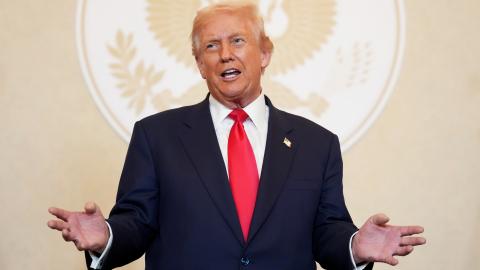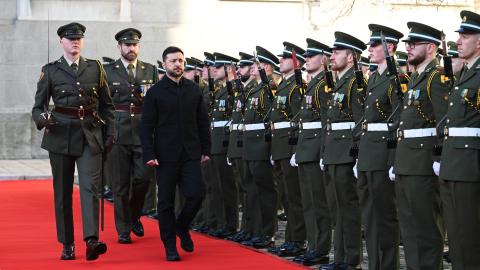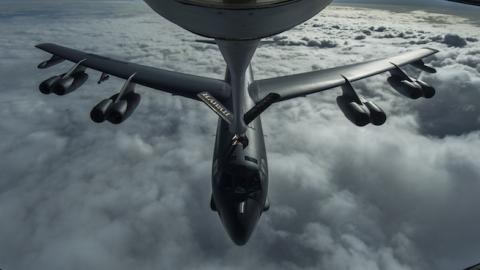At a time when hostile countries are investing in nuclear weapons and delivery systems, the future of the U.S. nuclear deterrent is at a critical juncture. Two of the candidates for our nation’s highest office recently signaled that they would mean trouble for the U.S. nuclear force. Campaigning in Iowa, former Secretary of State Hillary Clinton flippantly remarked that the Obama administration’s plan to modernize our nuclear force “doesn’t make sense” to her, putting her to the left of the current president. And in the last Republican debate, reality-TV host Donald Trump demonstrated how clueless he is about the U.S. nuclear triad. Meanwhile, the Obama administration has, even if reluctantly, worked with Congress to provide funding for nuclear modernization.
However, some of the most important upgrades have met with opposition from the same kinds of groups Hillary Clinton was pandering to with her “doesn’t make sense” remark. For instance, opposition to the upgraded precision-guided nuclear bomb, the B-61 model 12, and the nuclear cruise missile, the LRSO, reveals the stubborn “balance of terror” thinking that persists in corners of the defense establishment. The B-61 variant has gained support from the Obama administration and Congress, and has been flight-tested, and so the opposition is unlikely to affect the program in the near term. The LRSO program, although it too has congressional support, is less mature, and opponents are pressuring the administration to cut it in the next budget submission.
Proponents of President Obama’s plan to move toward a world “free of nuclear weapons” balked last year when the Air Force flight-tested a mock version of the B-61 model 12. Disarmers claim the refurbished warheads violate the pledge in the 2010 Nuclear Posture Review (NPR) not to develop new nuclear warheads and to use only nuclear components based on previously tested designs for refurbished weapons. But the refurbished weapons do use components from existing warheads, albeit in different combinations.
The new variant of the traditional B-61 bomb is able to strike its intended target with greater accuracy than its predecessor. The other important improvement is the ability to dial up or down the nuclear yield. The smaller the weapon’s yield, the smaller the extent of collateral damage. The ability to dial down the yield combined with the increased accuracy makes the B-61 model 12 the epitome of a counterforce weapon, designed to target the hardened and deeply buried tunnels and facilities countries like North Korea possess. Inside those tunnels is the very heart of the terror regime’s ability to coerce — its growing nuclear-weapons arsenal.
The LRSO cruise missile could be used to clear the way for a bomber with great precision and low nuclear yields, and it can be launched from a safe distance. General Stephen Wilson, then-commander of the Air Force Global Strike Command, explained, “There may be air defenses that are just too hard, it’s so redundant, that penetrating bombers become a challenge. But with standoff, I can make holes and gaps to allow a penetrating bomber to get in, and then it becomes a matter of balance.”
So why would any American politician oppose the modernization of U.S. nuclear weapons to improve their accuracy and flexibility, and permit them to have lower yields? Primarily, because these politicians fear that such weapons would be more tempting for an American president to use. What these politicians forget is that the United States has successfully deterred the worst kinds of war by promising that it is willing to employ nuclear weapons should the security of Americans require it. In order for enemies to be deterred by American nuclear weapons, they have to believe the United States is actually willing to use them. And, as the great Herman Kahn succinctly put it, “Usually the most convincing way to look willing is to be willing.” James N. Miller, the former Obama undersecretary for defense policy who helped structure the nuclear-modernization program, explained, “Minimizing civilian casualties if deterrence fails is both a more credible and a more ethical approach.” In other words, it makes it more likely that the United States could be willing to employ these weapons, and, therefore, they offer a more credible deterrent.
To oppose the B-61 model 12, the LRSO, and any other weapon that would enable the United States to effectively hold a spectrum of foes’ and potential foes’ military facilities at risk while minimizing civilian casualties, is in effect to support maintaining a nuclear force that promises less accuracy with greater collateral damage. Those are the options before defense planners. And the second option is based on the Cold War “balance of terror” model. Those skeptical about moving toward a more credible, modern force believe that the United States and its competitors will be mutually deterred if nuclear weapons threaten larger-scale collateral damage. And if the U.S. nuclear force has only options that would cause unacceptably high civilian casualties, the United States will be self-deterred from employing those weapons, and nuclear war will be avoided and “strategic stability” maintained — as if the primary goal of U.S. defense planners should be to deter the United States.
In fact, few national leaders, including those in Pyongyang, would believe that any U.S. president would actually employ a nuclear weapon that would kill high numbers of hapless, starving North Korean peasants. And because they wouldn’t believe it, threatening to do so would not deter North Korean leaders. At the heart of effective deterrence is having the ability to target what our enemies value. The North Korean regime values its survival, and its survival is maintained by its nuclear arsenal buried in those hardened facilities and tunnels. And, unlike the United States, which has been working to develop low-yield, high-accuracy weapons, the North Koreans are seeking to develop higher-yield weapons designed to execute a countervalue strategy, which targets cities. Just last week, North Korea conducted its fourth underground nuclear test since 2006.
Opponents of modernized nuclear weapons also complain that investing in our decaying nuclear force, including maintaining all three legs of the nuclear triad, betrays President Obama’s pledge to take the world down the path to zero nuclear weapons, as laid out in his 2009 Prague speech. The president did set out to make good on this ideologically driven agenda, but his plan was abruptly derailed by world events.
For starters, he couldn’t get the Senate to ratify the nuclear-arms-reduction treaty, New START, without making a commitment to modernize the remaining force. Then, Russia invaded Ukraine, identified NATO and the United States as national threats, and violated the Intermediate-Range Nuclear Forces (INF) Treaty; it continues to threaten to use nuclear weapons. There was simply no way President Obama could move forward with further cuts to the U.S. deterrent, and his administration understood the necessity of refurbishing some of the weapons — like the B-61 variant. But, while the president does support some of the most crucial modernization efforts, he has not supported everything that must be done.
According to a remarkable editorial in yesterday’s Wall Street Journal, Energy Secretary Ernest Moniz sent a letter to White House budget director Shaun Donovan last month about funding shortfalls for our nuclear complex. As the Journal reports, “Without an additional $5.2 billion for out-years 2018 to 2021, the budget will ‘lack credibility with Congress and stakeholders’ and ‘fuel uncertainty’ within the Energy Department’s National Nuclear Security Administration (NNSA). . . . Yet the White House is set to request only half the funding needed for facilities between 2018 and 2021.”
The Obama administration should leave the next president with a nuclear force as flexible and credible as possible. This means, in part, that the next budget should close the gaps outlined in Secretary Moniz’s letter, and the B-61 model 12 and the LRSO should be given priority. Most importantly, the American people must ensure that the next president fully appreciates the indispensability of a strong and modern nuclear deterrent and will follow through with its modernization.


















